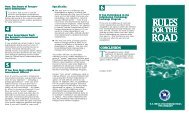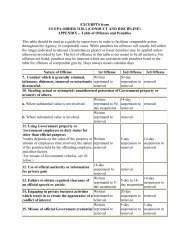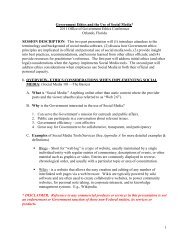Roadmap & Planning Workbook - US Office of Government Ethics
Roadmap & Planning Workbook - US Office of Government Ethics
Roadmap & Planning Workbook - US Office of Government Ethics
You also want an ePaper? Increase the reach of your titles
YUMPU automatically turns print PDFs into web optimized ePapers that Google loves.
The system shall automatically generate an email notification to the Filer.<br />
The system shall automatically generate an email notification when the Filer eSigns/submits the the<br />
OGE-278 FDR.<br />
The system shall automatically generate an email notification to the Reviewer when the Filer<br />
eSigns/submits an OGE-278 FDR.<br />
The system shall allow authorized users to generate an ad hoc e-mail.<br />
Form Administration<br />
The system shall allow authorized users to access an “Application Administration View” to perform<br />
administrative functions.<br />
The system shall provide an interface for the administrator to create and maintain referential data used in<br />
the FDR (i.e. drop-down lists).<br />
The system shall allow administrators upon direction <strong>of</strong> the DAEO (or designee) to delete erroneous records<br />
(even if submitted).<br />
The system will allow the administrator to maintain saved records by initiating, either manually or<br />
automatically, the archiving or de-archiving <strong>of</strong> FDRs based on established criteria. In this regard, see the<br />
National Archives and Records Administration (NARA), toolkit for managing electronic records,<br />
http://toolkit.archives.gov/pls/htmldb/f?p=102:1:11077972001844564795::NO. The NARA eRecords<br />
Management Resource Guide includes links to records management principles that apply to electronic<br />
signature technology generally, http://www.archives.gov/records-mgmt/policy/electronic-signaturetechnology.html,<br />
and records management guidance to Federal agencies for PKI digital signature<br />
authenticated and secured electronic transaction records. http://www.archives.gov/recordsmgmt/policy/pki.html.<br />
The latter includes:<br />
Requirements Definition and Implementation <strong>Planning</strong><br />
Information Systems (IS)11 http://www.archives.gov/records-mgmt/policy/pki.html#footnote11#footnote11,<br />
including those that agencies use to implement PKI-based electronic transaction applications, will produce<br />
new records or augment existing records. A critical first step in several <strong>of</strong> the system development stages is<br />
the identification, definition, development, and refinement <strong>of</strong> the data model that includes treatment <strong>of</strong> the<br />
PKI-based digital signature transaction records that will be created and should be managed. …<br />
Technical Architecture<br />
Network facilities within the security architecture should enable session timeouts based on configurable<br />
inactivity thresholds.<br />
The system must support 50,000 users and be capable <strong>of</strong> scaling to support 300,,000 users.<br />
The architecture must not require the installation <strong>of</strong> s<strong>of</strong>tware on end-user computers beyond standard<br />
browsers.<br />
Web servers in the e-Form computing environment providing confidential information or financial<br />
transactions must securely identify and authenticate themselves to users. The system should not permit<br />
web server’s to be positioned in front <strong>of</strong> the firewall.<br />
The application and security architecture must support the defined user roles and levels <strong>of</strong><br />
permissions/access to FDR data.<br />
The system should provide a standards-based Relational Database Management System (RDBMS).<br />
The system shall support the following environments.<br />
• Micros<strong>of</strong>t SQL Server 2003<br />
• Internet Explorer<br />
• E-mail platforms – Exchange/Outlook<br />
Administration<br />
The system must provide an administrative interface to facilitate the creation and deletion <strong>of</strong> user accounts,<br />
and modify associated account permissions. The system should provide for this capability to be delegated<br />
to any level <strong>of</strong> an agency.<br />
The system should <strong>of</strong>fer a facility, for use by select authorized administrators, which would enable the<br />
locking <strong>of</strong> a selected user account.<br />
33














